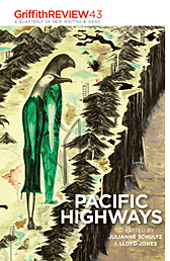Featured in

- Published 20140204
- ISBN: 9781922182241
- Extent: 300 pp
- Paperback (234 x 153mm), eBook
FOR A NUMBER of years I travelled on a New Zealand passport. It wasn’t so much that I identified with the land of my birth, but for pragmatic reasons: when I first needed a passport to travel – fittingly to the Pacific – I was a student, and a New Zealand passport cost less than half an Australian one, and lasted twice as long. Even if I hadn’t been back since I left at age four, for a penurious twenty-year-old, this was as good a reason as any to identify internationally as a Kiwi.
In the 1970s the boundaries between being a Kiwi and being an Aussie were blurred, and had been for half a century. Citizenship seemed interchangeable, with accompanying rights and responsibilities. My Australian parents happened to be living in Hamilton when I was born, so I was entitled to both, before opting to be officially stamped Australian.
Long before the formal free trade agreements, which focused on goods, services, capital and quarantine, there was effectively a free movement of people that bound the countries together. It was an uneven trade that benefitted Australia, as more left New Zealand than arrived – Australians flocked to even more distant shores.
The movement of people has continued, although the rules have changed – official Australian Government web pages bristle with daunting category classifications – but seem to have done little to stem the flow. More than 650,000 New Zealanders call Australia home, while 60,000 Australians have made a permanent journey east across the Tasman.
The dream of a united Australasia may have withered in the nineteenth century, but the sense of interchangeability lingers – like cousins who keep in touch, but keep a distance – bumptious and pushy city types on the western shores of the Tasman, versus the kids from the bush on the east.
NEW ZEALAND REMAINS Australians’ preferred holiday destination, and as they pour off the planes, they will readily agree it is arguably, inch for inch, the most beautiful country in the world. Green, watery, hilly, lush – the opposite to the ancient, flat, dry plains of Australia.
When they notice the country at all, Australians still tend to talk down to New Zealand, imagining we are in the big league; a continent, rather than a sparsely populated country on the edge of Asia. So while Australians were busy looking north and west, to the east something changed. New Zealand not only made a virtue of its environment, but became home to some of the best wines, movie directors, writers, footballers, sailors, scientists, educators and female leaders in the world.
It not only maintained, but developed its history of social innovation. It found new depth in the richness of its human and environmental capital. It continued its evolutionary path – since seafaring Polynesians followed the stars and currents to arrive in Northland about a thousand years ago, followed hundreds of years later by settlers from Europe, Asia and the Americas – to become an even more innovative, humane society at the crossroads of the Pacific, Tasman and Great Southern Oceans.
In an evolutionary sense, modern Australia and New Zealand grew out of similar stock. Notwithstanding a very different Indigenous history and the legacy of convict settlement in Australia, a hundred years ago they were recognisably similar, inheritors of the Enlightenment, and southern outposts of the British Empire. Despite close economic ties, they have now diverged in ways that to Australian eyes are unexpected and rewarding and truly original. New Zealand is not a depleting white society, as Australians may once have thought, but an emerging polyglot nation of four and half million people where all children learn Māori in school, where cultural diversity has taken deep root, where the natural environment is a resource to be treasured and there is water everywhere.
This edition of Griffith REVIEW has been shaped by Lloyd Jones’ passionate connection to his country, and showcases some of the best writers a highly literate society has produced. It does not shirk from the challenges, but celebrates the evolution of New Zealand into a truly connected hub more than able to provide imaginative sustenance and hold its place in the global village.
From an Australian perspective this edition has provided a wonderful opportunity to change the focal length in the way we see New Zealand. It jettisons the old clichés, and even more recent ones – there is not a sheep, hobbit, bottle of sauvignon blanc, ski field or rugby player to be found – displaced by something that is surprisingly rich, sophisticated and passionate.
From a New Zealand perspective, I hope that this edition provides a mirror on the evolution of a remarkable and resilient society through the eyes and words of your own; we are just holding the mirror so you can see from a slight distance. And from my point of view, I am pleased to synthesise these two elements of my own life.
Sydney, 2 December 2013
Share article
More from author

Move very fast and break many things
EssayWHEN FACEBOOK TURNED ten in 2014, Mark Zuckerberg, the founder and nerdish face of the social network, announced that its motto would cease to...
More from this edition

Simply by sailing in a new direction
EssayIN OCTOBER 2012 several dozen writers from New Zealand appeared at the Frankfurt Book Fair where New Zealand had been nominated as the 'country...

First, build your hut
EssayWHERE IS OUR Marcus Clarke? Henry Handel Richardson? Rolf Boldrewood, Ada Cambridge, Tasma, Henry Kingsley, Joseph Furphy? Why don't we have the rich history...

Primate city
EssayNOT LONG AGO a TV current affairs program mounted a live studio debate about whether 'Auckland is sucking the life out of New Zealand'....